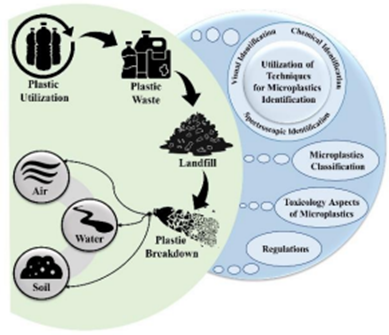Current Happenings ENVS News
- A Critical Analysis of Solid Waste Microplastics January 10, 2023

Solid waste is primarily an overlook source of Microplastics that contribute to a delirious amount of pollution to the environment. Thus, a clear understanding of the occurrence and degradation pathways of solid waste microplastics is critical to develop exhaustive control strategies. Dr Deblina Dutta, Assistant Professor, Department of Environmental Science, has published a paper titled, “An insight on sampling, identification, quantification and characteristics of microplastics in solid wastes” in the Q1 journal Trends in Environmental Analytical Chemistry, having an Impact Factor of 13.62.
Abstract of the Research
Microplastics (MPs) have attracted wide attention worldwide as a remarkable pollutant. While MPs spread throughout several complex environmental matrices, various experiments have been preliminarily concentrated on aquatic ecosystems. Terrestrial sources namely solid waste-origin have remained unexplored, although they contribute largely to the origin of aquatic microplastics. Simultaneously, terrestrial systems under human activity, like healthcare units, are likely to be polluted by various plastic ingredients. Solid waste MPs sources primarily include sanitary landfilling, food waste, wastewater treatment end-product (sludge), tire wear, textile washing and paint failure. These microplastics cause adverse impacts on the ecosystem, environment, and health. Accordingly, the present study addressed solid waste MPs’ occurrence and sources, identification, quantification, characterisation, fate, and degradation pathways for developing comprehensive management strategies following the principles of a circular economy.
In particular, this paper critically demonstrated solid waste MPs sources, solid waste MPs sampling followed by identification and quantification by adopting combined chemical (e.g., spectroscopy viz., Fourier transform infrared (FTIR) spectroscopy, and Raman spectroscopy), physical (e.g., microscopies such as transmission or scanning electronic microscopy, TEM or SEM) and thermal analyses. Additionally, the strengths and limitations of each analytical technique are discussed critically with practical aspects. Further, national and international regulations or laws and their subsequent relevance to solid waste MPs management with future challenges are critically discussed. Finally, the outcomes of the review paper will be valuable to different stakeholders for effective policy implementation.

Explanation of the Research in Layperson’s Terms
The published paper deals with microplastics (5 mm to 0.1 μm in size) present ubiquitously in the natural environment including rivers, lakes, estuaries, atmosphere, oceans, soil/sediments, landfilling sites, and wastewater treatment plants. However, microplastics are also present in solid waste and studies related to their identification, characterisation, and quantification are very scarce. Therefore, to know more about microplastics and understand the sources of microplastics in solid waste, the extraction procedures, the identification, characterisation, and quantification techniques, and finally the advantages and disadvantages of each of the processes involved in the identification, characterization, and quantification techniques of microplastics, this study has been carried out.
Practical Implementation/ Social Implications of the Research
Waste-assisted plastic pollution is a major global concern with socio-economic, ecological, and health effects. The present study will make society understand the source of microplastics in solid waste along with its extraction procedures, identification, characterisation, and quantification techniques. If society is aware of the adverse effects of microplastics, then only one can think to protect the environment and human health.
Collaborations
The research has been carried out in collaboration with the University of Burdwan, the University of North Bengal, and CSIR-NEERI, Nagpur.
It is now widely recognised that microplastic pollution poses a serious threat to the environment on a global scale. Having originated from a diverse source, it has persisted in various ecosystems, thereby entering the trophic chain. It has contributed to microplastic pollution in the environment, e-waste being a major source of it. Hence, along with metal recovery from e-waste, regulating microplastic pollution is a growing interest. At this juncture, Dr Dutta’s future research is directed towards resource recovery processes, regulating microplastic pollution, risk assessment, life cycle assessment, and techno-economics analysis.
Continue reading → - Study on C and N dynamics in response to climate change October 25, 2022
 Tropical forests are the breathing lungs of the world that work as a collective to stabilise climate by absorbing vast amounts of carbon dioxide. Covering over 12% of Earth’s total land surface. It functions as a harbour for evolution and supplying prerequisite rainfall for healthy vegetation. Recent global climate changes have catalysed drastic effects on the tropical forests and the healthy functioning of the same. A critical understanding of the present state of forest ecosystems is crucial for undertaking necessary measures to prevent further degradation.
Tropical forests are the breathing lungs of the world that work as a collective to stabilise climate by absorbing vast amounts of carbon dioxide. Covering over 12% of Earth’s total land surface. It functions as a harbour for evolution and supplying prerequisite rainfall for healthy vegetation. Recent global climate changes have catalysed drastic effects on the tropical forests and the healthy functioning of the same. A critical understanding of the present state of forest ecosystems is crucial for undertaking necessary measures to prevent further degradation.Recently, the project entitled Assessment and modelling of carbon and nitrogen dynamics in tropical forests of Eastern Ghats, Andhra Pradesh in response to climate change, has been sanctioned to Dr Javid Ahmad D, Assistant Professor, Department of Environmental Science by DST – SERB (Science and Engineering Research Board), Govt of India, with a total outlay of Rs. 28.54 lakhs. Dr Javid Ahmad D is the principal investigator of the project.
A complete dataset on long-term dynamics in vegetation, the C and N generated for different tropical forest types in the Eastern Ghats landscape would serve as a baseline data for forest managers and policy-makers. The project aims to gain insight on the response of these tropical forests to changing global climate in relation to multiple factors (elevated CO2, increased temperatures and altered precipitation).
Continue reading →

